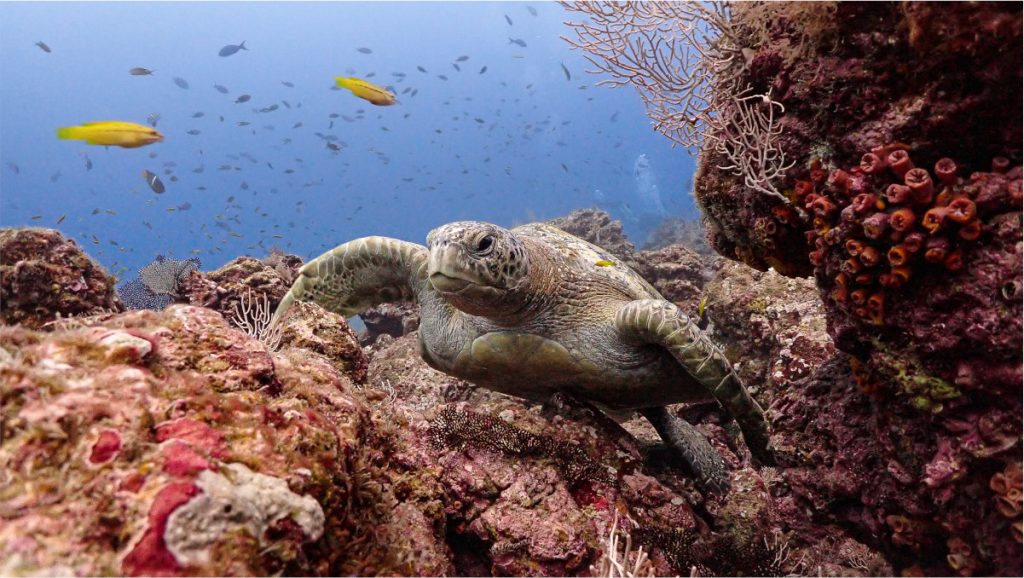Recently, I had a conversation with Maike Heidemeyer, a skilled biologist and Director of Biodiversity for a prominent NGO in Mexico. Maike spent several years living in Costa Rica, where she specialized in marine turtles, accumulating extensive knowledge and a deep passion for the ocean, something we both share. I hold her in high regard, not just for her scientific expertise, but also for her genuine love for the sea.
A Memorable Encounter
During our chat, Maike shared a memorable experience from a recent dive we organized at Caño Island, a place we have explored together numerous times. On this occasion, as she descended towards the reefs, she found herself surrounded by five turtles that showed no fear of her presence. For her, it was an awe-inspiring moment but also a cause for some concern. She wondered if these animals were becoming too accustomed to humans, which could potentially alter their natural behavior.
Unlike Maike, I can’t help but feel delighted by these interactions. I love the feeling of being able to see them up close and enjoy their presence without them swimming away at the slightest movement. For me, these encounters signify a unique and evolving connection between the turtles and visitors to the island.
Why Caño Island is a Great Place to See Turtles
1. Nesting Sites
Caño Island serves as a vital nesting ground for several species, including:
- Olive Ridley (Lepidochelys olivacea)
- Green Turtle (Chelonia mydas)
- Hawksbill Turtle (Eretmochelys imbricata)
These turtles come to the island’s beaches to lay their eggs, providing visitors with a rare opportunity to witness this natural phenomenon.

2. Conservation Efforts
Caño Island is part of the protected Caño Island Biological Reserve, dedicated to preserving marine species and their habitats. These efforts are crucial, as turtles face multiple threats, such as illegal hunting, accidental capture in fishing nets, and habitat destruction. Conservation initiatives by organizations like Reserva Playa Tortuga also play a significant role in protecting these creatures.
3. Snorkeling and Diving
The waters surrounding the island are perfect for snorkeling and diving. The vibrant reefs and diverse marine life provide an ideal setting for encountering turtles while exploring the underwater world. Visibility at Caño Island often exceeds 20 meters, allowing for unforgettable experiences with these magnificent creatures.
4. Year-Round Sightings
Turtles are observed throughout the year, particularly Olive Ridleys and Hawksbills, making Caño Island a unique destination for year-round turtle encounters. This continuous presence is supported by the rich marine ecosystem and conservation efforts in the area.
Key Turtle Species at Caño Island
Green Turtle (Chelonia mydas)
- Feeding Behavior: Primarily feeds on seagrasses and algae, essential for maintaining the health of marine meadows and coral reefs.
- Reproduction and Life Cycle: Green turtles return to the same beaches to nest, and after laying their eggs, hatchlings face a perilous journey to the ocean.
- Threats: Habitat destruction, illegal hunting, bycatch, climate change, and plastic pollution.
- Best Time to See Them: Year-round, with increased activity during nesting seasons.
Olive Ridley Turtle (Lepidochelys olivacea)
- Feeding Behavior: Opportunistic feeders that consume a variety of invertebrates such as crabs, shrimp, and jellyfish.
- Reproduction and Life Cycle: Known for their “arribadas”, mass synchronized nesting events mainly from July to December.
- Threats: Habitat destruction, bycatch, illegal egg collection, and marine pollution.
- Best Time to See Them: During arribadas, from July to December, with peak activity between August and October.
Hawksbill Turtle (Eretmochelys imbricata)
- Feeding Behavior: Predominantly feeds on sponges, though it also consumes other marine invertebrates.
- Reproduction and Life Cycle: They nest on their natal beaches and juveniles spend their early years in open ocean currents before settling in coastal reef habitats.
- Threats: Habitat destruction, illegal hunting for their shells, climate change, and bycatch.
- Best Time to See Them: Year-round, especially around coral reefs.
The Importance of Turtles in Marine Ecosystems
Turtles play a crucial role in maintaining marine ecosystems. Green turtles help control the growth of seagrasses, keeping these underwater meadows healthy. Hawksbills are vital to coral reef ecosystems as they feed on sponges, which allows corals to grow and thrive. Olive Ridleys contribute to nutrient cycling through their nesting activities. Protecting these turtles is essential to preserving the balance of the ocean’s complex ecosystems.
Important Aspects to Consider While Diving with Turtles
Preparing for Your Dive at Caño Island
- Choose a Certified Dive Center: Opt for a PADI 5-Star Dive Center to ensure safe and professionally guided dives.
- Understand Your Diving Level: Whether you’re a beginner or an advanced diver, Caño Island has suitable dive sites for all levels. Beginners should get training at centers in Uvita, Sierpe, or Drake, while experienced divers can explore deeper areas with higher chances of encountering turtles.
- Respect Turtle Behavior: Turtles are often near rocky reefs or gracefully swimming in open waters. Maintain a respectful distance to allow for safe interactions.
Additional Marine Life and Coral Reefs
While turtles are a primary attraction, Caño Island’s waters host a remarkable array of marine biodiversity. Divers frequently encounter schools of tropical fish, rays, white-tip reef sharks, and occasionally, giant manta rays and dolphins. The well-preserved coral reefs are ideal for underwater photography and exploration.
Seasons and Diving Conditions
Diving is possible year-round, but the dry season (December to April) offers the best visibility and calmer seas, making it easier to reach more distant dive sites. During the rainy season (May to November), turtle sightings are still frequent, though there may be occasional rain and slightly reduced visibility.
Uvita, Sierpe, and Drake: Ideal Starting Points
The best launch points for exploring Caño Island are Uvita, Sierpe, and Drake. These locations offer a range of certified dive centers and accommodations, from jungle lodges to beachfront bungalows. Feel free to contact me privately for more information or personalized details on planning your diving adventure.
Tips to Make the Most of Your Diving Trip
- Book in Advance: Caño Island is a popular destination, especially during peak seasons.
- Bring an Underwater Camera: Capture memories of vibrant marine life and stunning underwater landscapes.
- Respect the Environment: Caño Island is a protected area. Follow your dive center’s guidelines and avoid touching or disturbing marine life. Always practice responsible diving.
Encountering a Turtle While Snorkeling: What to Do
If you see a turtle while snorkeling, stay calm and observe from a distance. Enjoy watching them in their natural habitat, and remember to respect their space.
Best Time for Diving with Turtles in Costa Rica
| Turtle Species | Best Time to See | Location |
|---|---|---|
| Green Turtle | Year-round, especially nesting | Coastal areas, seagrass beds |
| Olive Ridley Turtle | July to December (arribadas) | Caño Island, nesting beaches |
| Hawksbill Turtle | Year-round | Coral reefs |
Conclusion
Diving at Caño Island offers a unique opportunity to explore one of Costa Rica’s most impressive underwater ecosystems. With its thriving marine life, including majestic turtles, and its crystal-clear waters, it’s no wonder Caño Island has become a must-visit destination for divers worldwide. Whether you’re a beginner or an experienced diver, diving with turtles at Caño Island is an experience that will leave a lasting impression.

As a Costa Rican diving instructor, I’ve had the privilege of exploring nearly all of my country’s underwater treasures, including the incredible Isla del Coco. After spending a decade guiding diving tours and sharing my love for the ocean, I co-founded a dive center that has grown into one of the most respected in Costa Rica. Together with my brother, we also launched Saltwater Connection, an online travel agency focused on marine adventures. Beyond Costa Rica, I’ve been fortunate to dive around the world, and when I’m not underwater, I find peace in sailing. One of my greatest joys is to show visitors the beauty of Costa Rica, offering them a fresh and unique perspective.


